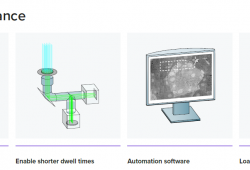Ultraszybki zautomatyzowany wielowiązkowy mikroskop elektronowy – FAST -EM
Opis
FAST-EM to ultraszybki zautomatyzowany wielowiązkowy mikroskop elektronowy (EM) przeznaczony do tworzenia złożonych i dużych projektów mikroskopowych w sposób prosty i wydajny. Dzięki zautomatyzowanej akwizycji, ten wysokowydajny system jest idealny do obrazowanie dużych lub wielu próbek do analizy ilościowej.
Dostarcza wielu informacji zachowując jednoczesny prosty worflow. System pozwala użytkownikom na szybką zmianę uwagi z analizy materiałów za pomocą mikroskopu do jednoczesnej analizy danych. FAST-EM może być używany do eksploracji architektury komórek do tzw. the interaction of neuronal circuits i analizy dowolnych materiałów biologiczny.
Jest to niezwykle przydatne narzędzie do obrazowania 3D dużych próbek, obrazowanie 2D na dużą skalę i jako narzędzie, które może znacznie przyspieszyć codzienną mikroskopię za pomocą mikroskopu elektronowego.
Specyfikacja
| Optyka elektronowa | |||||
| System bazowy | Thermo Fisher Scientific Apreo 2 | ||||
| Emitter: | Schottky field emission source | ||||
| Emitter stability: | Per 24 hours | 3% | |||
| High tension range: | 2.5-10 kV | ||||
| Beamlet current: | 400-800 pA | ||||
| Total current: | 25.6-51.2 nA | ||||
| Electron beam resolution: | (35-65% edge) | 4 nm | |||
| Nominal working distance: | 5 mm | ||||
| Single beam mode: | Yes | ||||
| Skanowanie oraz detekcja | |||||
| Multiprobe arrangement: | Square, 8 x 8 array | ||||
| Beamlets: | 64 | ||||
| Dwell time: | 400 ns minimum, adjustable | ||||
| Pixel size: | During field acquisition | 4 nm | |||
| Field of view: | At 3.2 μm pitch | 25.6 x 25.6 um | |||
| Detectors | Multibeam | Transmission detector with 64 silicon photomultiplier cells | |||
| Single-beam | Segmented in-lens backscattered electron detector | ||||
| Upper in-lens secondary electron detector | |||||
| Próbka oraz stolik | |||||
| Type | 3 axes motorized (XYZ) | ||||
| Stage position readout | Laser interferometry for nanometer-level positioning accuracy | ||||
| Travel range XY | 50 × 50 mm | ||||
| Typical substrate size | 14 x 14 mm* | ||||
| Max simultaneous substrates | When using 14 × 14 mm substrates | 9 – for a total of ~850 1*1 mm sections | |||
| Imaging workflow | |||||
| Usable samples | Directly on scintillators | Resin sections (maximum thickness of 150 nm), nanoparticles, vesicles, viruses | |||
| On TEM grids** | Resin sections (maximum thickness of 150 nm), nanoparticles, vesicles, viruses | ||||
| Unattended run-time | 72 hours | ||||
| Use cases | Routine data collection | Semi-automated imaging of user-defined ROIs and section arrays | |||
| Sustained throughput | During megafield acquisition at 400 ns | 100 megapixels/second | |||
| Data format | One 16-bit TIFF per field image, stored per project | ||||
| Software | |||||
| Microscope control | Linux-based acquisition control | ||||
| Acquisition support | User guidance for basic operations | ||||
| System health monitoring | Continuous logging of crucial system features | ||||
| Automatic calibrations | Detector gain, detector alignment, autostigmation, autofocus, global alignment of components | ||||
| Próżnia i wspierające oprzyrządowanie | |||||
| Vacuum pumps | Turbomolecular pump, scroll pump (backing) | ||||
| Operational vacuum | ≤ 3 × 10-5 mbar | ||||
| Network storage connection | 10 Gbit Ethernet (10GBASE-SR using LC Duplex OM3 MM fiber) | ||||
| Komponenty opcjonalne | |||||
| High performance storage module | Scalable high-speed storage for data analysis and data sharing | ||||
| Support Infrastructure | Standalone water chiller | ||||
| Acoustic enclosure for backing pump | |||||
| Consumables | 14 × 14 × 0.15 mm scintillator substrates | ||||






